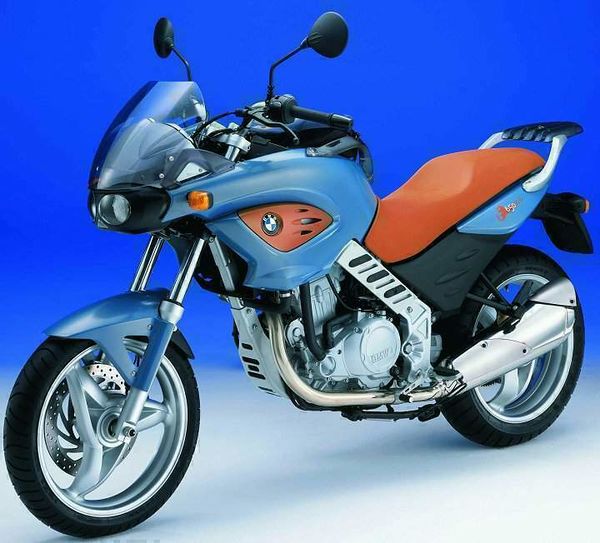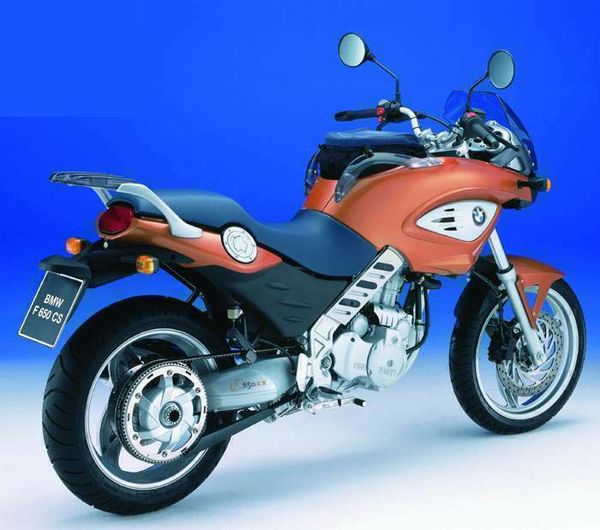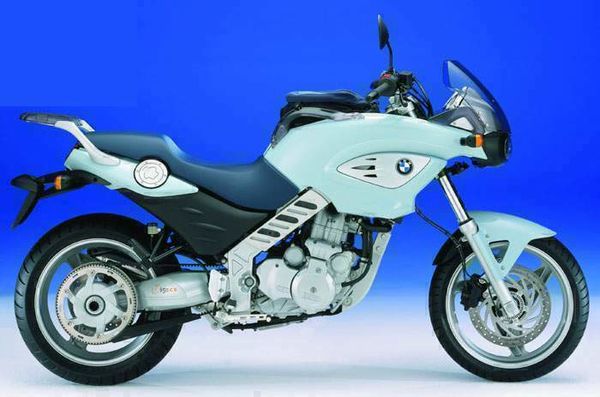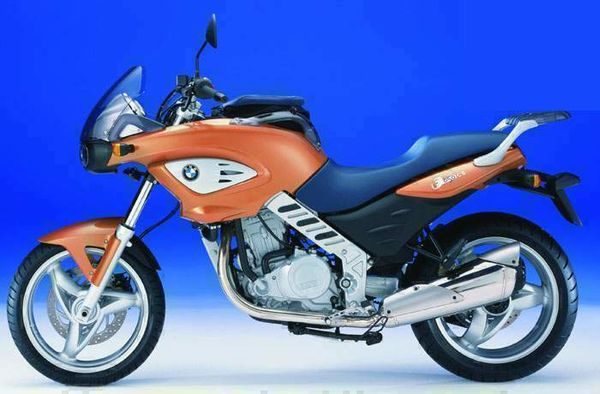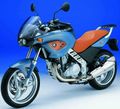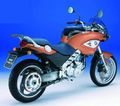BMW F650CS
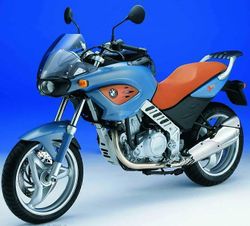 |
|
| BMW F650 | |
| Manufacturer | |
|---|---|
| Also called | F650GS SE, F 650 GS SE, F 650 CS, F 650, F650GS, F650GS Dakar, F650ST, F650ST Strada, F650CS Scarver, F650CS, F 650 ST Strada, F 650 ST, F 650 GS Dakar, F 650 GS, F 650 CS Scarver |
| Production | 2001 |
| Engine | Four stroke, single cylinder, DOHC, 4 valves per cylinder |
| Compression ratio | 11.5:1 |
| Top Speed | 175 km/h / 108.7 mph |
| Ignition | Electronic ignition integrated with fuel management |
| Spark Plug | NGK D8EA `01-06 [1] |
| Battery | YUASA YB12AL-A `01-06 |
| Transmission | 5 Speed |
| Final Drive | Belt |
| Frame | Bridging consisting of steel profiles. |
| Suspension | Front: ∅41mm Telescopic fork with integral brace Rear: Steel swingarm with progressive shock linkage |
| Brakes | Front: Single ∅300mm disc 2 piston caliper Rear: Single ∅240mm disc 1 piston caliper |
| Front Tire | 110/70 ZR17 `01-06 <ref name="wps_street_2019"> |
| Rear Tire | 160/60 ZR17 `01-06 <ref name="wps_street_2019"> |
| Wheelbase | 1493 mm / 58.8 in. |
| Seat Height | 780 mm / 30.7 in. |
| Weight | 170 kg / 374 lbs (dry), 187 kg / 412 lbs (wet) |
| Oil Filter | K&N KN-151 |
| Fuel Capacity | 15 Liters / 4 US gal. |
| Related | BMW F650 BMW F650GS |
| Manuals | Service Manual |
It could reach a top speed of 175 km/h / 108.7 mph.
Engine[edit | edit source]
The engine was a Liquid cooled Four stroke, single cylinder, DOHC, 4 valves per cylinder. The engine featured a 11.5:1 compression ratio.
Drive[edit | edit source]
Power was moderated via the Multi disc in oil bath.
Chassis[edit | edit source]
It came with a 110/70 ZR17 front tire and a 160/60 ZR17 rear tire. Stopping was achieved via Single ∅300mm disc 2 piston caliper in the front and a Single ∅240mm disc 1 piston caliper in the rear. The front suspension was a ∅41mm Telescopic fork with integral brace while the rear was equipped with a Steel swingarm with progressive shock linkage. The F650CS Scarver was fitted with a 15 Liters / 4 US gal. fuel tank. The bike weighed just 170 kg / 374 lbs. The wheelbase was 1493 mm / 58.8 in. long.
Photos[edit | edit source]
Overview[edit | edit source]
The CS is BMW's 2002 take on the F650 Strada bike. Like the Strada, the CS is a lightweight roadster, aimed at novice motorcyclists and commuters. Based around the F650GS engine and chassis, the CS's engine shares its advanced engine management system and cylinder head design. The chassis is similar, with the exception of the road-biased wheels and tires, and a low-maintenance belt drive. Around town, the F650CS is as easy to ride as the scooters it aims to supplant in European city centres. Soft suspension gives excellent comfort, and low-down weight distribution means good balance. Where a conventional bike has its fuel tank, the CS has an adaptable space which can hold luggage, helmet or a stereo.
Road Test
Ever heard of David Robb? Well, now you have. This bespectacled chap stands behind all of the controversial two-wheeled stuff that's been coming out of Munich lately, prompting the established Beemer fraternity to wonder where it's all going to end. Before you rule him out as just another sophisticated European designer, the guy's an American, a bachelor of the famous Pasadena Art Center Automotive Design department. His team's latest creation, the F650CS, has left many a journo a bit perplexed to say the least. What the hell IS that? I mean, previous incarnations of the F650 family could still be somehow related to street-oriented dual-purpose mounts--"Funduros" in BMW's terms. But this?! The new F650CS "Scarver" seems to have carried the street-terizing of the F series to its final resting place, an all-street model, while breaking a few rules in the process. For instance, one look at the available color range for the CS (with mix'n match panels) will convince you that some fashion designer had a hand in the choice, surely not the sort of stuff that'll attract the hardcore black leather crowd. But that's entirely OK with BMW, the F650CS is clearly targeted at a non-traditional, new riding crowd. Snowboarding youngsters that haven't grown up on Triumphs, maybe girls who want their scoot to look as cool and up to date as the transparent faceplate they just fitted to their Nokia cell-phone. Rule yourself out if you are over 30 or have grease under your fingernails--and check out Robb's interview on the CS.
The cool and fashionable theme is apparent in endless details. Satin finished transparent plastic parts abound and are not limited just to little details. Major parts like the whole rear luggage rack, tank handles and front screen mounts remind you of current computer peripherals such as HP ScanJet printers. It's nice to see, though, that some serious thinking went also into making the life of those young urban professionals much easier and not just cooler looking. A multi purpose cargo area is carved into the fake gas tanks (real one is under the seat) and the mentioned handles allow for easy strapping of a backpack, helmet, optional hard case or even a dedicated stereo into said cavity.
It's hard not to acknowledge the audacity of BMW in taking such a big step into uncharted territory
Mechanically, it's a totally new model, with only the engine being carried over from the GS. While leaving its off-road origins behind, the CS got rid of its spoke wheels, which are replaced by cast 17" items shod with street tires. A belt final drive replaces the old chain and is mated to a single-sided rear swing arm. The novel combination of these elements, especially the bold rear belt wheel, gives the rear end peculiar and powerful looks while requiring near zero maintenance or cleaning. The frame, although similar to the one on the GS, has larger section tubes which serve as the oil tank for the dry sump engine. Those strangely decorated panels on the flanks are there to prevent any fashionable baggy nylon trousers from melting on the hot frame tubes.
We could start here our own little debate about the F650CS's design but since I am almost sure that I don't belong to BMW's target market population, I'll keep my mouth almost shut on this one. Buck Rogers design or not, the CS turns out to be a pleasant road machine, even surprising in some aspects. After swinging a leg over it, I am rewarded with a really low and comfy seat and my hands fall naturally on the bars. A serious complaint with the 650GS was the proximity of the handlebars to the rider and this has been remedied in the CS with a lot more arm room. The black plastic lined "tank" cavity in front of me almost begs for some stuff to be stowed in. I haven't got hold of BMW's dedicated backpack so I gingerly throw in my regular courier bag, which seems happy to sit there even without strapping.
Switch on, injection fuel pump does its little whirling noise, ABS check light turns off, press the starter button without ever touching the throttle and engine starts pumping steadily. First gear goes in with a slight clunk and off we go. In the first urban maneuvers, the CS feels a bit strange, the long reach to the handlebars feels a little odd initially but after a few minutes and at higher speeds, the seating position comes into its own. The CS is amazingly happy to change directions and avoid the city's potholes, while the low seat height conveys a sense of security that new riders will surely appreciate. Gut feeling also says that the engine management chip has been somewhat remapped since throttle response is far less abrupt than the one I remember from the GS. Although a single, the 650's power unit likes to rev rather than plonk Honda-XR style.
Soon as we enter the highway the free breathing allowed by the CS downdraft throttle body lets the rider use all the available rev range without much tapering off of power near the 7500 rpm redline. A good 110 mph showing on the clock tells how strong the CS single runs up high. Back to a sedate 90 mph pace, which is more in line with the riding position, the slightly canted-forward ergoes transforms the CS into a better open-road mount than its predecessors. (On a long trip on a 650GS, I remember having to sit on the passenger portion of the saddle to fit my 6'4" frame within the confines of the handlebar.) Speaking of highway comfort, a little more wind protection than the one supplied by the existing screen would be welcomed by tall pilots, also better mirrors that don't turn around at speed. A single will never be without vibrations, but those of the CS are pretty well contained by its balance shafts.
And now for an interesting trick, cover with your hand the body work of the CS in a side view picture and you'll notice that under the swoopy covers, all the basics of a good supermoto are right there. BMW might want us to believe that the CS is just a Yuppie tool, but with that 160-section rear tire, sticky Bridgestone Battlaxes and stiff frame, the F650CS excels in slow twisties. The CS loves being thrown with abandon into hairpins and other mountainous stuff, while the suspension keeps things in check remarkably well considering they were calibrated for quieter action. It's the kind of bike on which it's easy to search for your limits. Eventually the pegs drag, but that's only when you are already using the last few millimeters of untouched tread. OK, its no real competition for a KTM Supermoto; for that it'd have to weigh a good 80 pounds less and have stiffer suspension, but as an entertaining tool for the occasional canyon jaunt, the little CS is more than impressive. The ABS brakes fall in line with BMW's policy of keeping you from hurting yourself, but for sporting use I'd rather have the normal (and available) setup. The front is a bit tough to modulate, and I think I felt a little fork flex now and again, or was it my courier bag shifting?
It's hard not to acknowledge the audacity of BMW in taking such a big step into uncharted territory--trying to attract non-riders. The Big IF is, is this going to work? Aprilia tried to pull a similar trick with its Moto 6.5, penned by celebrity designer Phillip Starck. It looked unlike any street bike before and earned a place in the Gugghenheim's Art of the Motorcycle exhibition, but not in the hearts of riders.
Maybe times have changed? Judging from the success of past David Robb creations, such as the R1200C, maybe the man knows what he's doing. Just don't tell the upwardly mobile young professionals that besides being a contemporary design showcase, the CS is also a fun curvy road tool.
Source Motorcycle.com
2001 BMW F 650 CS Scarver[edit | edit source]
The 2001 MY BMW F 650 CS Scarver has been designed as a successor to the F 650 ST Strada, and boasts visual improvements that are sure to fit the taste for the younger among Beemer fans, such as a more aggressive overall look and continuous lines from nose to rear. It has, at its heart, a liquid-cooled, four-stroke, 652cc, single cylinder powerhouse paired to a five-speed manual transmission, and can produce a claimed 50 horsepower and 62 Nm of torque.
It also boasts standard features such as a 41mm telescopic front fork, an adjustable mono-shock in the rear with progressive linkage, front and rear disc brakes, lightweight, cast-aluminum wheels, a dual seat, a rear luggage rack and an analogue instrument cluster.
2002 BMW F 650 CS Scarver[edit | edit source]
The 2002 MY BMW F 650 CS Scarver sports a liquid-cooled, four-stroke, 652cc, single cylinder powerplant mated to a five-speed manual transmission, and can reach a maximum power output of 50 horsepower and 62 Nm of torque.
In addition, it comes with a 41mm telescopic front fork, an adjustable mono-shock in the rear with progressive linkage, front and rear disc brakes, lightweight, cast-aluminum wheels, a dual seat, a rear luggage rack and an analogue instrument cluster.
2003 BMW F 650 CS Scarver[edit | edit source]
The 2003 MY BMW F 650 CS Scarver is a middle-class, naked machine that is sure to appeal to the younger among riders, thanks to its modern and aggressive design, as well as premium features such as the 41mm telescopic front fork, an adjustable mono-shock in the rear with progressive linkage, front and rear disc brakes, lightweight, cast-aluminum wheels, a dual seat, a rear luggage rack and an analogue instrument cluster.
In the tech/engine department, it sports a fuel-injected, liquid-cooled, four-stroke, 652cc, single cylinder engine paired to a five-speed manual transmission, and can produce a claimed 50 horsepower and 62 Nm of torque.
2004 BMW F 650 CS Scarver[edit | edit source]
The 2004 MY BMW F 650 CS Scarver has, at its heart, a fuel-injected, liquid-cooled, four-stroke, 652cc, single cylinder powerhouse mated to a five-speed manual transmission, that can reach a maximum power output of 50 horsepower and 62 Nm of torque.
It also comes with features such as a 41mm telescopic front fork, an adjustable mono-shock in the rear with progressive linkage, front and rear disc brakes, lightweight, cast-aluminum wheels, a dual seat, a rear luggage rack and an analogue instrument cluster.
Specifications[edit | edit source]
| Make Model | BMW F 650CS Scarver |
|---|---|
| Year | 2001 |
| Engine Type | Four stroke, single cylinder, DOHC, 4 valves per cylinder |
| Displacement | 652 cc / 39.8 cub. in. |
| Bore X Stroke | 100 x 83mm |
| Compression | 11.5:1 |
| Cooling System | Liquid |
| Induction | Electronic intake / BMW engine management |
| Ignition | Electronic ignition integrated with fuel management |
| Starting | Electric |
| Clutch | Multi disc in oil bath |
| Max Power | 37.3 kW / 50 hp @ 6800 rpm |
| Max Torque | 62.3 Nm / 6.4 kgf-m / 46 ft-lbs @ 5500 rpm |
| Transmission | 5 Speed |
| Final Drive | Belt |
| Gear Ratios | 1st 2.75 / 2nd 1.75 / 3rd 1.31 / 4th 1.05 / 5th 0.84:1 |
| Frame | Bridging consisting of steel profiles. |
| Front Suspension | ∅41mm Telescopic fork with integral brace |
| Front Wheel Travel | 125 mm / 4.9 in. |
| Rear Suspension | Steel swingarm with progressive shock linkage |
| Rear Wheel Travel | 120 mm / 4.7 in. |
| Front Brakes | Single ∅300mm disc 2 piston caliper |
| Rear Brakes | Single ∅240mm disc 1 piston caliper |
| Wheels | Die cast aluminum |
| Front Rim | 3.0 x 17 |
| Rear Rim | 4.5 x 17 |
| Front Tire | 110/70 ZR17 |
| Rear Tire | 160/60 ZR17 |
| Steering Head Angle | 86° |
| Trail | 116 mm / 4.6 in. |
| Dimensions | Length: 2142 mm / 84.3 in Width: 915 mm / 36 in. (incl. mirrors) Height: 1158 mm / 45.6 in. (excl. mirrors) |
| Wheelbase | 1493 mm / 58.8 in. |
| Seat Height | 780 mm / 30.7 in. |
| Dry Weight | 170 kg / 374 lbs |
| Wet Weight | 187 kg / 412 lbs |
| Fuel Capacity | 15 Liters / 4 US gal. |
| Consumption Average | 4.5 l/100 km / 62 US mpg |
| Tank Range | 333 kms / 207 miles |
| Standing ¼ Mile | 13.5 sec |
| Top Speed | 175 km/h / 108.7 mph |
| Reviews | Motorsport it |
External Links[edit | edit source]
References[edit | edit source]
- ↑ 2019 Western Power Sports Catalog. Western Power Sports. 2019.
| |||||||||||||||||
